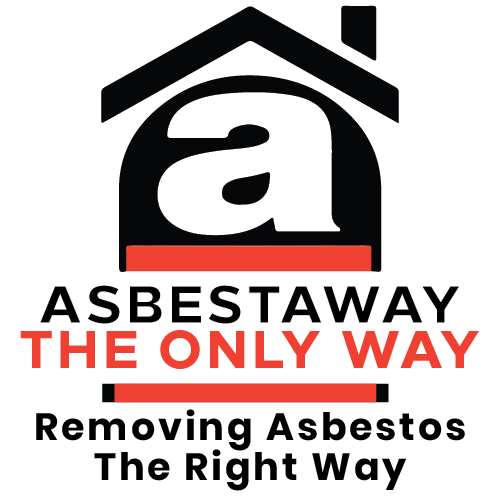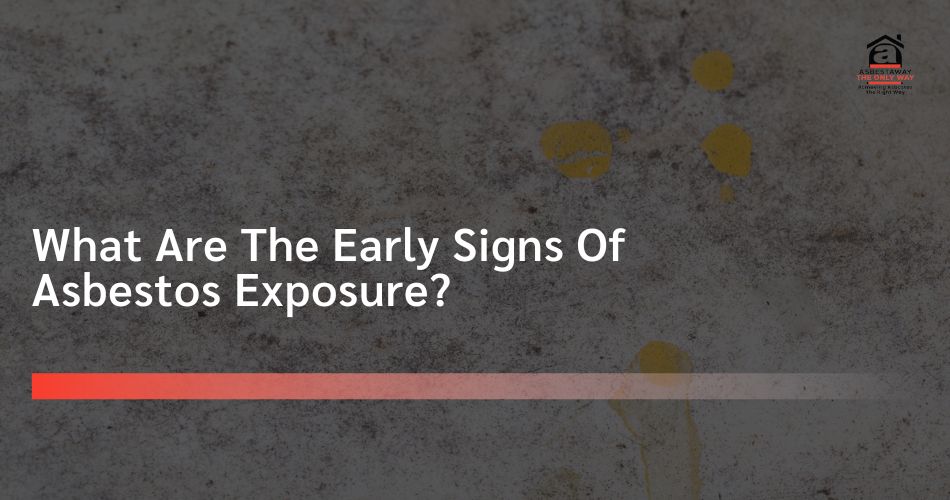Asbestos is a naturally occurring mineral that was widely used in construction, insulation, and other industries throughout the 20th century. While its popularity was due to its heat resistance and durability, asbestos is now known to be highly dangerous, especially when its fibers become airborne and are inhaled. Exposure to asbestos can lead to severe health issues, including lung cancer, asbestosis, and mesothelioma, a rare but aggressive form of cancer. The danger lies in the fact that the symptoms of asbestos-related diseases often don’t show up until decades after exposure.
In this blog, we will explore the early warning signs of asbestos exposure, how to recognize them, and the steps you can take to ensure your safety. Additionally, we will explain why it’s important to work with professionals like Asbestaway for asbestos testing and removal services to protect yourself, your loved ones, and your home or workplace.
Introduction to Asbestos Exposure
Before we dive into the signs of exposure, it’s important to understand how asbestos exposure occurs and why it’s so dangerous. Asbestos is made up of tiny fibers that are invisible to the naked eye. When these fibers become airborne and are inhaled, they can become lodged in the lungs or other parts of the respiratory system. Over time, this can cause inflammation, scarring, and genetic changes to cells, leading to various diseases.
While asbestos exposure is primarily associated with industries like construction, shipbuilding, and manufacturing, many older buildings (constructed before the 1980s) contain asbestos materials. People who work in these environments or live in older homes may unknowingly be at risk.
It’s also important to note that asbestos-related diseases can take years or even decades to develop, making early detection a challenge. However, knowing the early warning signs and seeking medical attention can make a significant difference in diagnosing and treating these conditions.
Early Warning Signs of Asbestos Exposure
If you have been exposed to asbestos, it’s crucial to be aware of the potential early signs of asbestos-related diseases. Below are some common symptoms that may indicate exposure to asbestos:
1. Persistent Cough or Coughing Up Blood
A persistent cough that doesn’t seem to go away could be an early sign of asbestos exposure, especially if it worsens over time. Coughing up blood, even in small amounts, is a more serious symptom that should never be ignored. It could be a sign of lung damage or even lung cancer, both of which are linked to prolonged asbestos exposure.
2. Shortness of Breath (Dyspnea)
One of the most common early symptoms of asbestos exposure is difficulty breathing or shortness of breath, even during routine activities. This happens because asbestos fibers can cause scarring or inflammation in the lungs, leading to reduced lung capacity. Over time, this can worsen and lead to severe respiratory distress. Asbestos-related diseases such as asbestosis (a chronic lung condition) or pleural disease (affecting the lining of the lungs) are often marked by shortness of breath.
3. Chest Pain or Tightness
Chest pain or a feeling of tightness in the chest could be indicative of a serious health issue. Asbestos exposure can lead to pleuritis (inflammation of the lining around the lungs) or pleural plaques (thickening of the lung lining), both of which can cause chest discomfort. Chest pain could also be a sign of more serious conditions like lung cancer or mesothelioma.
4. Fatigue and Weight Loss
Chronic fatigue and unexplained weight loss are often symptoms of advanced asbestos-related diseases. In particular, mesothelioma, a cancer of the lung lining, can cause significant fatigue and a loss of appetite, leading to dramatic weight loss. These symptoms might appear gradually and may be dismissed as a normal part of aging or a minor illness, but they could also indicate a more serious underlying condition caused by asbestos exposure.
5. Swollen Fingers or Toes (Clubbing)
Clubbing, or the swelling of the fingers and toes, is another sign that could be related to asbestos exposure. Clubbing is often seen in individuals with chronic respiratory diseases like asbestosis or lung cancer. It happens when there is a lack of oxygen in the bloodstream, which can be caused by impaired lung function due to asbestos exposure.
6. Hoarseness or Difficulty Swallowing
Asbestos exposure can sometimes lead to tumors forming in the lungs or the lining of the chest cavity. These tumors can put pressure on the vocal cords, leading to a hoarse voice or difficulty swallowing. If these symptoms persist, it’s essential to consult a doctor, as they could indicate the presence of cancer or another serious condition linked to asbestos.
7. Changes in the Skin or Nails
Asbestos-related conditions, particularly lung cancer and mesothelioma, may cause changes to the skin or nails. Some individuals may experience unusual skin conditions, including paleness or an orange hue, while others may develop nail abnormalities such as thickened or discolored nails.
Why the Symptoms Can Be Delayed
It’s important to understand why the signs of asbestos exposure may not appear immediately. Asbestos-related diseases, such as mesothelioma and asbestosis, can take anywhere from 10 to 50 years to develop. Asbestos fibers can lay dormant in the lungs for decades, gradually causing damage over time. This long latency period is one of the reasons why early detection is so challenging.
Moreover, the early symptoms of asbestos-related diseases often overlap with other, less severe illnesses, making it easy to overlook or misdiagnose. For example, shortness of breath, coughing, and fatigue are common symptoms of respiratory infections or other lung conditions, which is why they may not raise immediate concerns in individuals with a history of asbestos exposure.
What to Do If You Suspect Asbestos Exposure
If you have worked in an environment where asbestos exposure was possible, or if you live in an older home or building that may contain asbestos, it’s important to be vigilant about your health. Even if you are not experiencing symptoms, regular check-ups and screenings for asbestos-related diseases can be crucial in detecting any potential problems early.
Steps to Take:
- Consult with a doctor: If you are concerned about past asbestos exposure and are experiencing any of the symptoms listed above, it’s important to consult with a healthcare provider. They can conduct tests to determine whether there is any lung damage or asbestos-related disease.
- Get an X-ray or CT scan: Medical imaging can help identify any abnormalities in the lungs, such as pleural plaques, lung scarring, or signs of mesothelioma or lung cancer.
- Consider regular monitoring: People with a history of significant asbestos exposure may be advised to undergo periodic monitoring, including chest X-rays or CT scans, to catch any changes early on.
Why Consider Asbestaway for Asbestos Testing and Removal Services
If you live in an older building, work in an industry at risk for asbestos exposure, or suspect that you may have encountered asbestos, it’s essential to ensure that the material is safely removed or managed. Asbestos removal requires specialized knowledge, equipment, and certifications to handle the material safely. That’s where professional services like Asbestaway come in.
Asbestaway offers comprehensive asbestos testing, removal, and remediation services, designed to keep you and your family safe from the dangers of asbestos. Here’s why Asbestaway is a trusted choice for asbestos-related services:
- Expertise and Experience: Asbestaway’s team has years of experience dealing with asbestos testing, removal, and remediation. They understand the regulations and safety standards required to protect your health and home.
- Certified and Safe Removal: Asbestos is hazardous, and improper handling can lead to significant health risks. Asbestaway follows all local, state, and federal guidelines to safely remove and dispose of asbestos-containing materials.
- Comprehensive Testing: If you’re unsure whether your home or workplace contains asbestos, Asbestaway can conduct thorough asbestos testing to determine the presence of asbestos and recommend the best course of action.
- Peace of Mind: With Asbestaway, you can rest easy knowing that asbestos is being dealt with safely, allowing you to protect your health and the health of your loved ones.
Conclusion
Asbestos exposure can have serious long-term health effects, but recognizing the early warning signs and taking proactive steps to protect yourself can make a world of difference. If you have a history of asbestos exposure or live in an older home or building, it’s important to stay vigilant for symptoms such as persistent coughing, shortness of breath, chest pain, fatigue, and weight loss. Regular medical check-ups and early screenings can help identify potential issues before they become more severe.
If you suspect asbestos in your home or workplace, consider reaching out to a professional asbestos testing and removal service like Asbestaway to ensure the safe handling and removal of asbestos-containing materials. By doing so, you are taking an essential step in safeguarding your health and the health of your family.
Remember, early detection and professional intervention are key to reducing the risks of asbestos-related diseases. Stay informed, stay safe, and act quickly if you notice any of the early warning signs of asbestos exposure.

